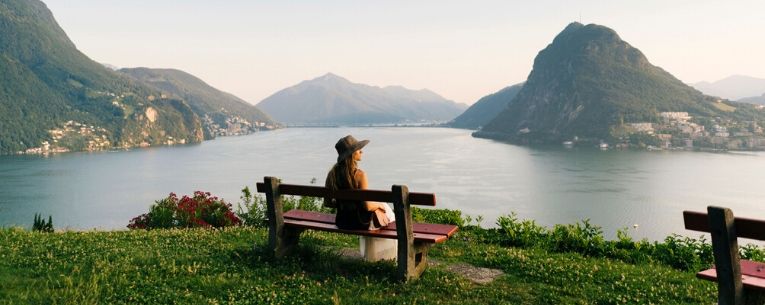Traveling sustainably is simpler than you think. You don’t have to pay extra for fancy gear or luxury eco-resorts; you just have to plan your trip thoughtfully, move mindfully, and spend your travel budget wisely. Here’s a list of 20 practical tips that may help you become a greener, low-impact traveler.
1. Take a “slow travel” approach to planning.
“Rather than attempting to squeeze as many sights or cities as possible into each trip, the slow traveler takes time to explore each destination thoroughly and to experience the local culture,” SmarterTravel explains.1 It’s better for the environment (imagine biking around one city instead of driving all around the country) and better for your brain, too.
2. Choose destinations that are known for sustainability.
Check the Environmental Performance Index, a scientific ranking of countries by environmental health and ecosystem vitality, to get ideas for green destinations. The top three countries are Switzerland, Denmark and Malta, but you don’t have to limit yourself to Europe; other high-ranking options are New Zealand, Japan, Taiwan and Costa Rica.
3. Stay close to home.
According to our Vacation Confidence Survey, more Americans are taking short “micro-cations” of four nights or less. Taking trips of shorter duration and distance can have a smaller environmental impact, compared to a long flight or cruise. Remember, your travel insurance can protect any trip that’s 100 miles or more from home.
4. Spend your money where it matters.
Instead of going to an overtouristed, booming destination, look for places where your tourist dollars can support local conservation, wildlife protection and reinvestment efforts. Consider visiting countries that are still rebuilding from natural disasters (as long as travel there is safe).
5. Buy zero-waste travel toiletries.
Don’t tote a ton of plastic around the world and then discard it at your destination. Consider zero-waste toiletries, such as shampoo and conditioner bars, toothpaste tablets, bamboo toothbrushes and deodorant bars.
6. Pack lightly.
The more weight in your suitcase, the more fuel is required to move it (especially when flying). Instead of packing to the max and ending up with a 49.5-pound suitcase, aim for a minimalist strategy. Remember: the most important thing you pack is travel insurance to protect your journey! Find the right plan for you.
7. Pick sunscreen carefully.
Oxybenzone and octinoxate, both common sunscreen ingredients, have been shown to damage corals and marine life. However, “reef-safe” can be a misleading term, Consumer Reports warns.2 To reduce your impact, wear a hat and cover-up, as well as mineral sunscreen.
8. Skip new clothes for your trip.
The fashion industry is the second-largest polluter in the world, contaminating water with dye, chemicals and microplastics.3 Before you stock up on cheap T-shirts or a new jacket, ask yourself: Can I get by with what I already have? Can I borrow certain things I need, or get them secondhand?
9. Choose earth-friendly footwear.
The one thing you may want to buy for your trip is a great pair of travel shoes. Invest in a pair that’s made ethically and sustainably; some favorite brands are Allbirds, TOMS, Veja and Alice + Whittles.4
10. Pack reusable utensils, bags and more.
A little foresight can help you avoid single-use plastics while traveling. Pack a few simple items: one or two cloth shopping bags, a basic set of metal cutlery, a durable container for snacks or leftovers, and a reusable straw.
11. Reduce the impact of your flight.
Air travel is a significant contributor to climate change.5 One of the best things you can do for sustainable travel planning is consider alternatives to flying, such as taking the train. If you must fly, consider flying economy, choosing an earth-friendlier airline (like JetBlue, which is making its U.S. flights carbon-neutral), or purchasing carbon offsets.
12. Choose a greener cruise line.
Cruise ships are cleaning up their act, with many ditching disposable plastics and improving efficiency.6 Virgin Voyages, for example, has launched its ships with technology that converts engine heat to electricity. Buffets are banned and all meals are made to order, reducing food waste.7
13. Research your hotel’s green creds.
It’s easy for a resort to call itself “green” or “eco” without doing much to earn that title. Before you book, do a little extra homework to find lodgings with truly sustainable features. In Maldives, a paradise that’s threatened by pollution and rising seas, a handful of resorts use solar power instead of diesel generators and purify water on-site instead of importing plastic bottles.
14. Start a dialogue about sustainable travel with your hotel or host.
If you chose your lodgings because of their green practices, tell them so! If you see something they could do better, let them know.
15. Cut your personal energy usage while traveling.
Air conditioning consumes huge amounts of electricity. Can you adapt to the local climate and open the window instead of turning the A/C on full blast? Alternatively, look for hotels with LEED certification, which means a building is extra energy-efficient.
16. Eat local.
It’s not just trendy; it makes sense. If you’re staying at a Caribbean resort, why order the steak that’s been frozen and flown in from the U.S.? Enjoy the island’s bounty of fruit and freshly caught fish instead.
17. Invest in a filtering water bottle.
Worldwide, we use 1 million plastic bottles per minute.8 Don’t add yours to the nightmare pile. If you’re traveling to a destination with questionable water quality, simply invest in a purifying water bottle. There are tons of simple options that filter and/or purify water for safe consumption.
18. Shun abusive wildlife “experiences.”
If an attraction allows you to pet, be photographed with, or ride a wild animal, that’s not education; it’s exploitation. Sloths held in captivity for tourist interactions, for instance, usually die within six months.9 Research any sanctuary before you visit, and respect the right of wildlife to roam free and undisturbed.
19. Shop for sustainably made souvenirs.
When buying gifts and keepsakes, look for locally made foods and crafts, not mass-produced junk or cheap T-shirts. Say no to anything made from wildlife: no preserved skins, insects, shells, furs or feathers.
20. Continue giving back after you return home.
The best part of travel is how it opens our eyes to the wonders of Earth. If your trip to the boreal forest or the Namibian savanna stirs your heart, then donate your money or energy to help protect these magical places.
Related Articles








Share this Page